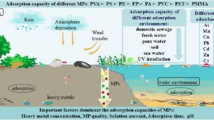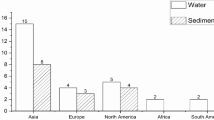Abstract
Purpose
The management of sediments from stormwater infiltration basins is nowadays a key issue for local authorities to ensure long-term performance. Speciation of pollutants is particularly required in view of reuse of these materials. If fractionation of trace metals in sediments is relatively well described, polycyclic aromatic hydrocarbons (PAHs) speciation was only studied using particle size distribution. Therefore, this study aims at the characterization of the PAHs-bearing fractions in sediments.
Materials and methods
Three sediments with various physicochemical properties were sampled in the west and north of France to characterize the distribution of PAHs among organic and inorganic components. Respective organic and inorganic matrixes were obtained by alkaline extraction and methyl isobutyl ketone (MIBK) fractionation procedure. The nature of the solid fractions was assessed through microanalyses: infrared spectroscopy (Fourier transform infrared spectroscopy), X-ray diffraction (XRD), and scanning electron microscopy with X-ray spectroscopy. Bulk sediments and extracted fractions were analyzed for organic matter parameters: elemental analysis (C, N, and H), total organic matter, total organic carbon, hydrocarbons (C10–C40), and PAHs.
Results and discussion
The characterization of bulk sediments highlighted that they were mainly composed of single particles, originating from the geological background, and aggregates (10 to 300 μm) composed of minerals and large organic matter content. The C/N ratio and PAH ratios were shown to be helpful for the determination of the natural or anthropogenic origin of organic matter or to evaluate additional contribution of industrial activities. The fractionation results underlined the role of the aggregates on the distribution of PAHs. Humin fraction and bound-humic acids were mainly composed of aggregates (10 to 150 μm) and accounted for 60 to 70 % of sample mass. The PAHs are mainly sequestrated in these fractions. Only up to 1 % of PAHs are adsorbed on the mineral fraction.
Conclusions
Both alkaline extraction and MIBK procedure demonstrated that PAH residues were readily sequestrated in humin and bound-humic acids fractions and that fulvic acids, humic acids, and mineral fractions contained poor concentrations of PAHs. Microanalyses underlined the high level of aggregation of particles in sediments and their mixed inorganic and organic nature. In case of stormwater sediments, the location of PAHs in highly organic aggregates is consistent with their sources, being both oil products and debris from vehicles and road.





Similar content being viewed by others
References
AFNOR (2000) NF EN 12879:2000 Détermination de la perte au feu de la matière sèche. Caractérisation des boues. (Quantification of dry matter by loss of ignition—application to sludges), AFNOR, Paris
AFNOR (1998) NF ISO 14235:1998 Dosage du carbone organique par oxydation sulfochromique. Qualité du sol. (Soil quality—determination of organic carbon by sulfochromic oxidation) AFNOR, Paris
Amellal N, Portal JM, Berthelin J (2001) Effect of soil structure on the bioavailability of polycyclic aromatic hydrocarbons within aggregates of a contaminated soil. Appl Geochem 16:1611–1619
Badin A-L, Faure P, Bedell J-P, Delolme C (2008) Distribution of organic pollutants and natural organic matter in urban storm water sediments as a function of grain size. Sci Total Environ 403(1–3):178–187
Badin A-L, Méderel G, Béchet B, Borschneck D, Delolme C (2009) Study of the role of organic matter in the aggregation of the surface layer of Technosols from stormwater infiltration basins by using grain size analyses with laser diffractometry. Geoderma 153:163–171
Baek SO, Field RA, Goldstone ME, Kirk PW, Lester JN, Perry R (1991) A review of atmospheric polycyclic aromatic hydrocarbons: sources, fate and behavior. Water Air Soil Pollut 60:279–300
Béchet B, Durin B, Legret M, Le Cloirec P (2010) Size fractionation of heavy metals in highway runoff waters. In: Rauch S, Morrison GM, Monzon A (eds) Highway and urban environment series: Alliance for global sustainability bookseries 17. Springer, New York, pp 235–243
Benhabib K, Simonnot M, Sardin M (2006) PAHs and organic matter partitioning and mass transfer from coal tar particles to water. Environ Sci Technol 40(19):6038–6043
Calderoni G, Schnitzer M (1984) Effects of age on the chemical structure of paleosol humic acids and fulvic acids. Geochim Cosmochim Acta 48(10):2045–2051
Campbell CA (1978) Soil organic carbon, nitrogen and fertility. In: Schnitzer M, Khan SU (eds) Soil organic matter. Elsevier, Amsterdam, pp 173–271
Cannavo P, Vidal-Beaudet L, Béchet B, Lassabatère L, Charpentier S (2010) Spatial distribution of sediments and transfer properties in soils in a stormwater infiltration basin. J Soil Sediment 10(8):1499–1509
Clozel B, Ruban V, Durand C, Conil P (2006) Origin and mobility of heavy metals in contaminated sediments from retention and infiltration ponds. Appl Geochem 21:1781–1798
Crabtree B, Moy F, Whitehead M, Roe A (2006) Monitoring pollutants in highway runoff. Water Environ J 20:287–294
Dechesne M, Barraud S, Bardin J-P (2004) Spatial distribution of pollution in an urban stormwater infiltration basin. J Contam Hydrol 72:189–205
Doick KJ, Burauel P, Jones KC, Semple KT (2005) Distribution of aged 14C-PCB and 14C-PAH residues in particle-size and humic fractions of an agricultural soil. Environ Sci Technol 39:6575–6583
Durand C, Ruban V, Amblès A, Oudot J (2004) Characterization of the organic matter sludge: determination of lipids, hydrocarbons and PAHs from road ponds. Environ Pollut 132:375–384
Durand C, Ruban V, Amblès A (2005) Characterisation of complex organic matter present in contaminated sediments from water retention ponds. J Anal Appl Pyrol 73:17–28
Durin B, Béchet B, Legret M, Le Cloirec P (2007) Influence of infiltration flow rate on trace elements mobilisation from an infiltration basin sediment. La Houille Blanche 5:120–126
El Mufleh A, Béchet B, Rodier C, Grasset L, Ruban V, Amblès A (2010) Speciation of trace metals in organic matter of contaminated urban sediments. In: 10th Urban Environment Symposium, Gothenburg, Sweden
Farell J, Reinhard M (1994) Desorption of halogenated organics from model solids, sediments and soil under unsaturated conditions I. Isotherms. Environ Sci Technol 28:53–62
Ghosh U, Zimmermann JR, Luthy RG (2003) PCB and PAH speciation among particle types in contaminated harbor sediments and effects on PAH bioavailability. Environ Sci Technol 37:2209–2217
Göbel P, Dierkes C, Coldewey WG (2007) Storm water runoff concentration matrix for urban areas. J Cont Hydrol 91:26–42
Guthrie EA, Pfaender FK (1998) Reduced pyrene bioavailability in microbially active soils. Environ Sci Technol 32:501–508
Hébrard-Labit C (2006) Recommandations pratiques pour la gestion des produits de l’assainissement pluvial (Practical recommandations for the management of stormwater sediments). Guide technique LCPC. Laboratoire Central des Ponts et Chaussées DISTC, Paris
Kleeman MJ, Schauer JJ, Cass GR (2000) Size and composition distribution of fine particulate matter emitted from motor vehicles. Environ Sci Technol 34(7):1132–1142
Lawrence AL, Marsalek J, Ellis JB, Urbonas B (1996) Stormwater detention and best management practices. J Hydraul Res 34(6):799–813
Legret M, Le Marc C, Demare D, Colandini V (1995) Pollution par les métaux lourds dans un bassin de décantation recevant des eaux de ruissellement d’origine routière (Traffic-induced heavy metals pollution in a stormwater management pond). Environ Technol 16:1049–1060
Legret M, Odie L, Demare D, Jullien A (2005) Leaching of heavy metals and polycyclic aromatic hydrocarbons from reclaimed asphalt pavement. Water Res 39(15):3675–3685
Marsalek J, Watt WE, Anderson BC (2006) Trace metal levels in sediments deposited in urban stormwater management facilities. Water Sci Technol 53(2):175–183
Mermillod-Blondin F, Nogaro G, Vallier F, Gilbert J (2008) Laboratory study highlights the key influences of stormwater sediment thickness and bioturbation by tubicid worms on dynamics of nutrients and pollutants in stormwater retention systems. Chemosphere 72(2):213–223
Milani M, Pucillo FP, Ballerini M, Camatini M, Gualtieri M, Martino S (2004) First evidence of tire debris characterization at the nanoscale by focused ion beam. Mater Charact 52:283–288
Ministry of Housing, Spatial Planning and Environment (1994) Intervention values and target values—soil quality standards. The Hague (the Netherlands): Directorate-General for Environmental Protection, p 19
Nieman JKC, Kimball DO, McLean JE, Sims RC, Sims JL, Sorensen DL, Rice JA (1998) Humidification of pyrene in contaminated soil during land farming. Proceedings of the 1998 Conference on Hazardous Waste Research: Bridging gaps in technology and culture, Snowbird, UT, May 18-21. Proceedings on the web at http://www.engg.ksu.edu/HSRC/98Proceed/
Pagotto C (1999) Etude sur l’émission et le transfert dans les eaux et les sols des traces métalliques et des hydrocarbures en domaine routier (Emission and transfert of traffic-induced heavy metals and PAHs in runoff waters and soils). Thesis. Poitiers University, France
Pétavy F (2007) Treatment and re-use of storm-water. Sediments Thesis. Nantes University, France
Pétavy F, Ruban V, Conil P, Viau J-Y, Auriol J-C (2009) Treatment and valorisation of stormwater sediments. Global NEST J 11(2):189–195
Rice J, MacCarthy P (1989) Isolation of humin by liquid–liquid partitioning. Sci Total Environ 81(82):61–69
Rockne KJ, Shor LM, Young LY, Taghon GL, Kosson DS (2002) Distributed sequestration and release of PAHs in weathered sediment: the role of sediment structure and organic carbon properties. Environ Sci Technol 36:2636–2644
Ruban V (2005) Caractérisation et gestion des sédiments de l’assainissement pluvial (Characterisation and management of stormwater sediments). EG19. Laboratoire Central des Ponts et Chaussées DISTC, Paris
Sansalone JJ, Buchberger SG (1997) Partitioning and first flush of metals and solids in urban highway runoff. J Environ Eng 123:134–143
Zielinska B, Sagebiel J, Arnott WP, Rogers CF, Kelly KE, Wagner DA, Lighty JS, Sarofim AF, Palmer G (2004) Phase and size distribution of polycyclic aromatic hydrocarbons in diesel and gasoline vehicle emissions. Environ Sci Technol 38(9):2557–2567
Acknowledgments
This work has benefited from the financial support of the “Région des Pays de la Loire” in the framework of the research project POLESUR “Soil and water pollution in urban areas” (2008–2011).
Author information
Authors and Affiliations
Corresponding author
Additional information
Responsible editor: Nicholas Dickinson
Rights and permissions
About this article
Cite this article
El-Mufleh, A., Béchet, B., Grasset, L. et al. Distribution of PAH residues in humic and mineral fractions of sediments from stormwater infiltration basins. J Soils Sediments 13, 531–542 (2013). https://doi.org/10.1007/s11368-012-0586-x
Received:
Accepted:
Published:
Issue Date:
DOI: https://doi.org/10.1007/s11368-012-0586-x




